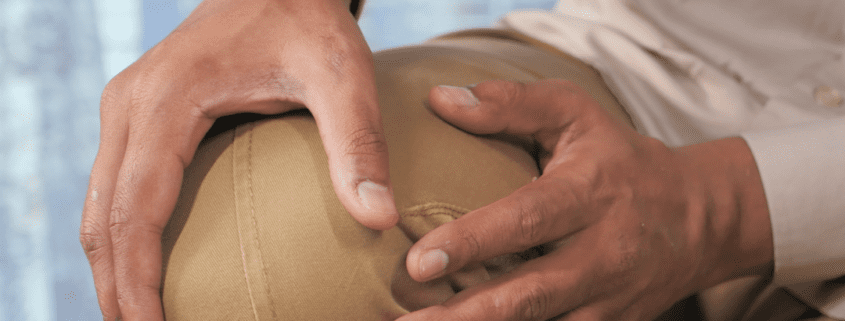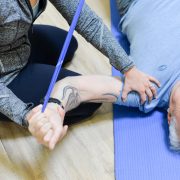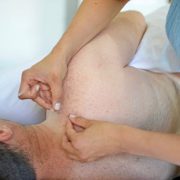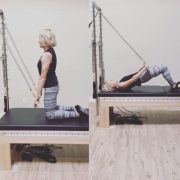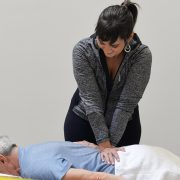Top 3 Causes of Knee Pain and What To Do.
Knee pain is the second most common complaint when it comes to musculoskeletal problems. Right behind back pain. It impacts one-third of all Americans at any given time. I speak to a lot of folks in their 50’s and 60’s who love to ski, run, hike and bike. Their biggest fear is that ongoing knee pain could bring an eventual end to their active lifestyles. The good news is that eighty percent of all knee problems can be resolved without procedures or surgery. But, it starts with accurately identifying knee pain causes.
Here are three common Knee Pain Causes and what you can do to resolve it.
1. Patellofemoral Knee syndrome
Also known as “runner’s knee”, Patellofemoral Knee Syndrome (PFS) is characterized by pain in the front of your knee. Usually just below or behind your knee cap.
With PFS, the source of the pain typically comes from unwanted pressure around your knee cap. That eventually results in inflammation and pain. It’s very tempting to just get a cortisone shot or take pain pills to quickly reduce the inflammation and relieve your pain. But unless you’re certain where the inflammation is coming from, you’re really only addressing the symptoms of your knee problem.
In other words, what causes the pressure in your knee cap to begin with?
It doesn’t just happen spontaneously. If you truly want to put an end to PFS, you’ll need to find the root cause of your problem.
Typically, PFS is the result of an imbalance somewhere in your body. Over time, it has resulted in poor form and movement habits that ultimately cause more pressure at your knee.
If your hips, quads, and hamstrings aren’t balanced and working together harmoniously, you could end up with problems in your knee.
Once you figure out the culprit behind the pressure and inflammation at your knee cap, you’ll be able to resolve and manage PFS naturally and for the long-term.
2. Iliotibial band syndrome
The causes of iliotibial band syndrome are very similar to that of PFS. Except that your pain and symptoms will be experienced on the side of your knee instead of the front.
Your iliotibial band (ITB) is a large, thick band of tissue that runs along the side of your thigh to the bottom of your knee. Your ITB is formed from a muscle in your hip called the tensor fascia latae (TFL). When your TFL gets overworked, your ITB suffers, and will result in what often feels like stabbing pain at the side of your knee.
The most common treatment I see for this is foam rolling and massage. While these are great modalities to relieve your symptoms, they don’t address the root problem.
You must figure out why your TFL is being stressed and overworked if you really want to get rid of your pain. Typically, it’s due to weak glute muscles, the deep ones designed to stabilize your pelvis.
Your TFL is neighbor to your glutes. So, when they decide to be lazy, your TFL loves to help out, and eventually overdoes it. When you can get these two groups of muscles working properly together, you’ll put an end to ITB syndrome.
3. Osteoarthritis
Many people find out they have osteoarthritis in their knees and think there’s nothing that can be done. They either have to “live with it” or get a total knee replacement.
First, arthritis is normal and it happens to everyone as they age. What is not normal is for you to think you’re helpless or have to avoid your favorite activities because of it.
Arthritis occurs when the protective cartilage that cushions the ends of your bones wears down over time. While there isn’t anything you can do to reverse this process, there is plenty you can do to minimize the symptoms you get because of this condition.
It all comes down to balanced joints and movement. The more mobility you have, and the more stability you have around your knees, the less symptomatic your arthritis will be.
Some key areas to focus on when you’ve got arthritis in your knees is good core and hip strength, and good flexibility in your hips and ankles.
If anything is off in these areas, your knees will compensate, which could result in compression at your knee joint. This will aggravate your arthritic symptoms.
“Motion is lotion” isn’t just a saying.
It very well could be the difference between you suffering from debilitating knee symptoms versus living an active lifestyle despite your osteoarthritis.
If you’re suffering from knee pain, remember that there is a very good chance you fall into the eighty percent of people who can successfully get rid of it completely on their own.
There is no need to rely on pain pills, or believe that procedures and surgery are your only options. As you can see, three of the most common causes of knee pain are due to movement problems.
Therefore – movement should be your solution – not something you avoid.
Are you Local to Portsmouth, New Hampshire and experiencing knee or any other type of pain?
CLICK HERE to book a discovery visit with one of my specialists. Someone from my team will reach out to you. They’ll find out what’s been going on, and see if we’re a good fit for you to get you back to doing the activities that you love.
Dr. Carrie Jose, Physical Therapist and Pilates expert, owns CJ Physical Therapy & Pilates in Portsmouth and writes for Seacoast Media Group. To request a free copy of her Knee Pain Free Report CLICK HERE or to get in touch, email her at [email protected].

